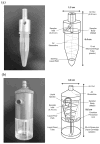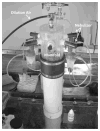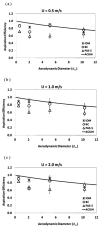Evaluation of physical sampling efficiency for cyclone-based personal bioaerosol samplers in moving air environments
- PMID: 22833144
- PMCID: PMC4649907
- DOI: 10.1039/c2em30299c
Evaluation of physical sampling efficiency for cyclone-based personal bioaerosol samplers in moving air environments
Abstract
The need to determine occupational exposure to bioaerosols has notably increased in the past decade, especially for microbiology-related workplaces and laboratories. Recently, two new cyclone-based personal bioaerosol samplers were developed by the National Institute for Occupational Safety and Health (NIOSH) in the USA and the Research Center for Toxicology and Hygienic Regulation of Biopreparations (RCT & HRB) in Russia to monitor bioaerosol exposure in the workplace. Here, a series of wind tunnel experiments were carried out to evaluate the physical sampling performance of these two samplers in moving air conditions, which could provide information for personal biological monitoring in a moving air environment. The experiments were conducted in a small wind tunnel facility using three wind speeds (0.5, 1.0 and 2.0 m s(-1)) and three sampling orientations (0°, 90°, and 180°) with respect to the wind direction. Monodispersed particles ranging from 0.5 to 10 μm were employed as the test aerosols. The evaluation of the physical sampling performance was focused on the aspiration efficiency and capture efficiency of the two samplers. The test results showed that the orientation-averaged aspiration efficiencies of the two samplers closely agreed with the American Conference of Governmental Industrial Hygienists (ACGIH) inhalable convention within the particle sizes used in the evaluation tests, and the effect of the wind speed on the aspiration efficiency was found negligible. The capture efficiencies of these two samplers ranged from 70% to 80%. These data offer important information on the insight into the physical sampling characteristics of the two test samplers.
Figures







Similar articles
-
A wind tunnel test of newly developed personal bioaerosol samplers.J Air Waste Manag Assoc. 2012 Jul;62(7):828-37. doi: 10.1080/10962247.2012.681422. J Air Waste Manag Assoc. 2012. PMID: 22866584
-
Performance of personal inhalable aerosol samplers in very slowly moving air when facing the aerosol source.Ann Occup Hyg. 2004 Jun;48(4):351-68. doi: 10.1093/annhyg/meh006. Epub 2004 Mar 2. Ann Occup Hyg. 2004. PMID: 15191944
-
Laboratory study of selected personal inhalable aerosol samplers.Ann Occup Hyg. 2010 Mar;54(2):165-87. doi: 10.1093/annhyg/mep079. Epub 2010 Feb 10. Ann Occup Hyg. 2010. PMID: 20147627
-
New experimental methods for the development and evaluation of aerosol samplers.J Environ Monit. 2002 Oct;4(5):633-41. doi: 10.1039/b202274p. J Environ Monit. 2002. PMID: 12400907 Review.
-
Characterisation of workplaces with risks of internal exposures: air sampling.Radiat Prot Dosimetry. 2007;124(3):274-9. doi: 10.1093/rpd/ncm397. Epub 2007 Aug 27. Radiat Prot Dosimetry. 2007. PMID: 17725980 Review.
Cited by
-
Control technologies to prevent aerosol-based disease transmission in animal agriculture production settings: a review of established and emerging approaches.Front Vet Sci. 2023 Nov 14;10:1291312. doi: 10.3389/fvets.2023.1291312. eCollection 2023. Front Vet Sci. 2023. PMID: 38033641 Free PMC article. Review.
-
Bioaerosols and Transmission, a Diverse and Growing Community of Practice.Front Public Health. 2019 Feb 21;7:23. doi: 10.3389/fpubh.2019.00023. eCollection 2019. Front Public Health. 2019. PMID: 30847337 Free PMC article. Review.
-
Bioaerosol Sampling: Classical Approaches, Advances, and Perspectives.Aerosol Sci Technol. 2020;54(5):496-519. doi: 10.1080/02786826.2019.1671950. Epub 2019 Oct 4. Aerosol Sci Technol. 2020. PMID: 35923417 Free PMC article.
References
-
- Lacey J, Dutkiewicz J. J Aerosol Sci. 1994;25(8):1371–1404.
-
- Fakhri ZI. In: Encyclopedia of Occupational Health and Safety. Stellman JM, editor. ch 38. International Labour Office; Geneva: 1998. p. 38.2.
-
- Aizenberg V, Reponen T, Grinshpun SA. Am Ind Hyg Assoc J. 2000;61(6):855–864. - PubMed
-
- Agranovski IE, Agranovski V, Reponen T, Willeke K, Grinshpun SA. Atmos Environ. 2002;36(5):889–898.
-
- Singh M, Misra C, Sioutas C. Atmos Environ. 2003;37:4781–4793.
Publication types
MeSH terms
Substances
Grants and funding
LinkOut - more resources
Full Text Sources
Other Literature Sources
Miscellaneous

